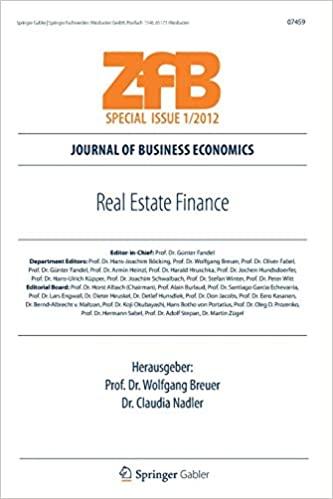Question
A farmer can choose to either plant corn or soybeans each year. The cost of planting corn is $50,000, and the cost of planting soybeans
A farmer can choose to either plant corn or soybeans each year. The cost of planting corn is $50,000, and the cost of planting soybeans is $30,000. Each crop can either produce a good or bad yield. The farmers revenue from a good yield of corn is $100,000 and the revenue from a bad yield of corn is $40,000. The farmers revenue from a good yield of soybeans is $60,000 and the revenue from a bad yield of soybeans is $50,000.
The farmer wishes to decide what to plant for year 1 and for year 2.
The probability of a good yield of soybeans is 0.7 in each year (regardless of what was planted in the previous year).
The probability of a good yield of corn is 0.6 in year 1. If corn is planted in year 1, the probability of a good yield of corn in year 2 is 0.3 (whether or not the yield from year 1 is good or bad).
If soybeans are planted in year 1 and the soybean yield is good, the probability of a good yield of corn in year 2 is 0.8. If soybeans are planted in year 1 and the soybean yield is bad, the probability of a good yield of corn in year 2 is 0.6.
The farmer wants to maximize his expected net present value. His MARR is 10%.
Assume that the costs of planting occur at the end of the previous year and the revenues occur exactly one year later. For example, if the farmer chooses to plant corn in year 1 and the yield is good and plants soybeans in year 2 and the yield is bad, he has the following cash flow:
Year 0 -$50,000 (planting corn for year 1)
Year 1 +$100,000 (good yield of corn) - $30,000 (planting soybeans for year 2) = $70,000
Year 2 $50,000 (bad yield of soybeans)
For this scenario (good corn, bad soybeans), the farmers net present value = $54,959.
Draw and solve a decision tree to determine what the farmer should plant for year 1 and for year 2. (The farmers decision on what to plant in year 2 may depend on what occurs in year 1.)
Step by Step Solution
There are 3 Steps involved in it
Step: 1

Get Instant Access to Expert-Tailored Solutions
See step-by-step solutions with expert insights and AI powered tools for academic success
Step: 2

Step: 3

Ace Your Homework with AI
Get the answers you need in no time with our AI-driven, step-by-step assistance
Get Started


